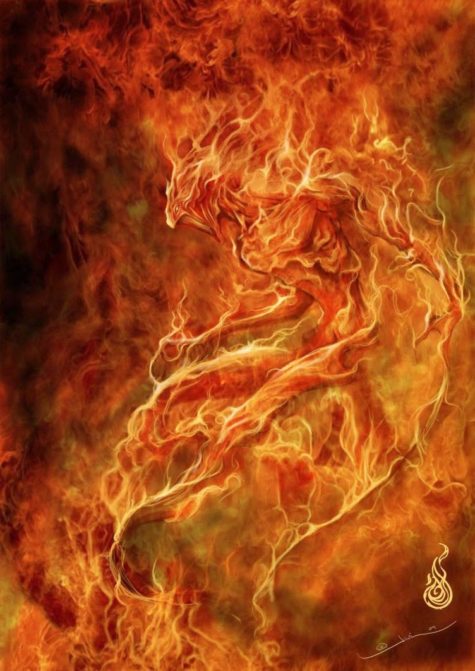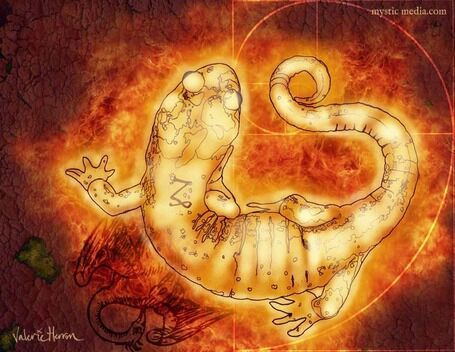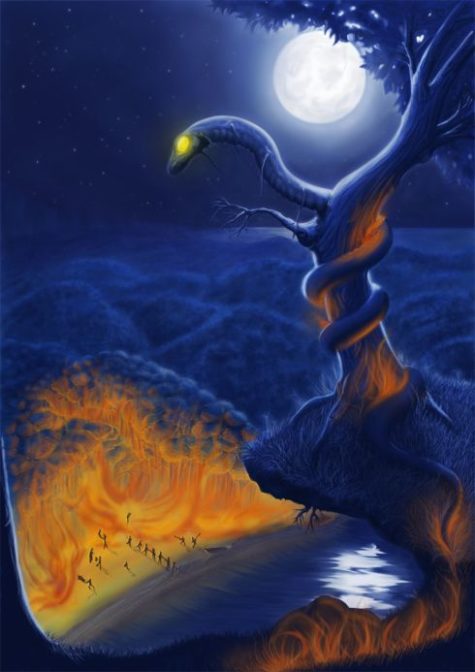Fire Spirits
“Be lit by the fires of life. They are transforming.
Nothing touched by fire ever remains the same.”
~Avia
- Element: Fire
- Direction: South
- Form: Lizard-like
- Heraldic signification: A brave and generous courage that the fire of affliction cannot destroy or consume.
- Key words: Wild, Bold, Sultry, Feisty, Lively, Energizing, Impetuous, Passionate, Consuming, Enlightening, Illuminating, Commanding
The elemental concept of, and the term salamander was coined by Paracelsus, a highly respected physician of the 16th century. They are fabled to have taught ancient man how to create and use fire.
The Salamanders are the elemental guardians of fire, they are here to control and contain flames. Fire is one of the most destructive elements on the planet and it is their job to ensure the planet safety from it. Salamanders also know how to use the destructive force of fire for good. Fire energy allows for renewal and regrowth. Every flame and fire has a guardian Salamander present. Anytime you are struggling to light a fire call upon the Salamanders to help.
The fiery elemental Salamander is no real relation to the amphibious salamander. Although, amphibian salamanders do live in moist logs and villagers of days gone by observed throwing logs on a fire caused salamanders to scurry out from the logs. For this reason, some of our more naive ancestors thought fire was the birth-giver of the salamander, and here we find a lore-connection to our fire elemental salamander.
Fiery Salamander Energy
Salamanders are not the lizards we see running around, they are found in the flames of a fire. They are darting, dancing and ever changing. Salamanders are associated with all things that have to do with heat and fire.
Salamanders are Elementals to be respected and possibly even feared. Think of how temperamental fire is: It erupts and destroys, it rages, it ravages. You do not want to be in the path of a rampaging Salamander! But, like the phoenix, this destruction brings rebirth. It allows us to start again. Salamanders purify by banishing the old and allowing the new to come to light, using the flame of the Sun to nurture growth.
The detoxification shows up in our bodies as well. When we are sick and run a fever, that is the Salamander energy burning off toxins. Salamander elementals also oversee the heat in our bodies, aka our metabolism. They set the regulator for how we ‘burn’ calories. Low fire means low energy, a slow metabolism and sluggishness. Without fire in our bodies we feel fatigue, lethargy, a lack of creativity, we lose the ability to concentrate and lose interest in sex (again, a creating energy).
As witches we will use a flame to signify burning negative energies and then we bury the ashes in the earth, cast them to the wind or run them under water – but it is the fire that destroys.
There are some essential oils and incenses that can help us conjure up the heat energy, my favorite is dragon’s blood, but you can use frankincense, patchouli, mugwork, heliochrysum, and of course sage. Herbs that help are cinnamon, peppermint, ginger, nutmeg, rosemary, and of course, pepper.
When we are healthy and the Salamander energy is flowing we feel confident, we are assertive, and vital. Too much Salamander and we get aggressive, rageful, arrogant and vain. To counteract this use herbs that ground or dampen.
Salamander Myth and Lore
Salamanders have long held a significant place in the folklore and mythology of many different countries around the world. Fantastic powers and attributes have been bestowed upon them giving them a place in mythology, alchemy, heraldry and popular culture that is perhaps surprising, for what in reality is a rather small, humble creature.
The lore continues to weave in and out of collective imagination as we learn elemental Salamanders were attributed for the presence of coronas or points of discharge. Commonly known as St. Elmo’s Fire, salamanders were thought to produce electric fields of energy, and sometimes great glowing orbs of fire.
Other ancient accounts tell of fire elementals living in volcanoes. Dormant volcano’s indicate contented, slumbering salamanders. When erupting, the salamanders’ wrath has been incurred, and their lava tongues come to lick up everything in their path.
The salamander is mentioned in the Talmud as a creature that is a product of fire, and it relates that anyone who is smeared with its blood will be immune to harm from fire. Rashi (1040–1105), the primary commentator on the Talmud, describes the salamander as one which is produced by burning a fire in the same place for seven years.
Saint Augustine in the City of God used the example of salamanders to argue for the possibility of humans being punished by being burned in eternal flame in Purgatory. He wrote “If, therefore, the salamander lives in fire, as naturalists have recorded, and if certain famous mountains of Sicily have been continually on fire from the remotest antiquity until now, and yet remain entire, these are sufficiently convincing examples that everything which burns is not consumed.”
Leonardo da Vinci (1452–1519) wrote the following on the salamander: “This has no digestive organs, and gets no food but from the fire, in which it constantly renews its scaly skin. The salamander, which renews its scaly skin in the fire,—for virtue.”
Pliny describes it as “a sort of lizard which seeks the hottest fire to breed in, but quenches it with the extreme frigidity of its body.” He tells us he tried the experiment once, but the creature was soon reduced to powder. *There was also a belief that the skin and other parts and extracts of the salamander gave protection against fire.
Early travelers to China claimed they had had been shown clothing reputedly woven from salamander hair that had been deliberately placed in a fire and came out unscathed. Today many people think that they were shown clothing made from asbestos fibers.
The salamander of mediæval superstition was a creature in the shape of a man, which lived in fire (Greek, salambeander, chimney-man), meaning a man that lives in a chimney. It was described by the ancients as bred by fire and existing in flames, an element which must inevitably prove destructive of life.
Gregory of Nazianzen says that the salamander not only lived in and delighted in flames, but extinguished fire. St. Epiphanius compares the virtues of the hyacinth and the salamander. The hyacinth, he states, is unaffected by fire, and will even extinguish it as the salamander does. “The salamander and the hyacinth were symbols of enduring faith, which triumphs over the ardor of the passions. Submitted to fire the hyacinth is discolored and becomes white. “We may here perceive,” says M. Portal, “a symbol of enduring and triumphant faith.”
The Poisonous Salamander Of Myth
The salamander was also reputed to be so toxic that if it entwined itself around a fruit tree then the fruits become poisonous to all who would eat them. The saliva was thought to cause the hair of a person to fall from the body if it made contact with human skin.
If a salamander got into a well then the well water would be poisoned and undrinkable. Many species of salamanders do secrete a toxic substance from their bodies when threatened but the toxicity of the substance was greatly exaggerated.
The salamander is found throughout French folklore, although in differing form. In addition or sometimes instead of its fire symbolism, it was attributed a powerful poison. Some legends say that merely by falling into a well, it would poison the water, and by climbing a fruit tree, poison the fruit. Its highly toxic breath was reportedly enough to swell a person until their skin broke; in Auvergne, it supposedly did the same to herds of cattle. This gained it the name of “bellows breath”.
Like the real animal, the legendary salamander breathed seldom; unlike the real salamander, the only way to kill one was said to be to lock it in a confined space so that it breathed its own poison. The Bretons feared it so they did not dare say its real name for fear it would hear and then kill them.
Channeled Message from the Salamanders
“We are the elementals of fire and come forward to bring through our wisdom for you at this time. We beings of fire bring forth the creative energies and the energies of transformation and change. Planet earth is evolving in more ways than one and at this time humanity has a choice whether to stagnate as a race or utilize the available cosmic energies and frequencies that the planet is being bathed with. We salamanders offer our wisdom to those who wish to embrace the new life opportunities presented. We are creators and utilizing the element of fire within you will allow you to move out of stagnation and into action and creativity. Call upon the salamander energy when you are manifesting and when you feel sluggish and stuck. We dance with delight within the flames and offer your soul the opportunity to dance with us.”
Sources:
- Alternate Names: Baitatá, Biatatá, Bitatá, Batatão, Batatá, Mboitatá, M’boiguaçu, Mbaê-Tata
- Origins: Brazilian mythology, legend and folklore
- Element: Fire, Water
- Species: Serpent
- Appearance: Flaming, bright, giant horned aquatic serpent, or glowing eyes in the dark
- Powers: Protects the Rainforest
- Manifestation: A giant snake with enormous fiery eyes that crawls over the open fields at night. Sometimes described as a giant fire snake.
Boitatá is a mythological serpent from Brazilian mythology, legend and folklore. It is the Brazilian equivalent of the will-o’-the-wisp. The name comes from the Old Tupi language and means “fiery serpent” (mboî tatá). Its great fiery eyes leave it almost blind by day, but by night, it can see everything.
The Boitatá is a good entity, but it may kill anything which is violating the forests. Their diet consists of eyes from dead animals or its victims.
According to the legend, there was once a long period of darkness when the sun did not shine and a deluge flooded the earth. These conditions killed many animals and forced the beasts to flee their natural habitat. A “boiguaçu” (a cave anaconda) left its cave after the deluge and, in the dark, went through the fields preying on the animals and corpses, eating exclusively its favorite morsel, the eyes of the dead, which shone brightly in the darkness and made for tasty delicacies.
As the snake ate more and more of these delicious, shiny eyes, its body began to shine. The collected light from the eaten eyes gave “Boitatá” its fiery gaze, but the eyes-only diet steadily weakened it, and it perished… in a blaze of glory. For, upon its death, all the light collected inside it escaped to the sun, and the dark days were finally over.
There must have been some magic in all those eyeballs, because the boitatá lived on in spirit. It inhabits the Amazon jungles to this day, often appearing at night as nothing but two glowing, fiery eyes. Some say it can breathe fire as well, an ability it uses to incinerate people who harm the rainforest by chopping trees down or starting fires.
Others say it can actually disguise itself as a tree trunk, then roast alive any lumberjack who comes to cut it down. It is also said that it will blind you and make you insane if you gaze into its eyes.
Variations:
There are other versions of the legend that describe the boitatá as a giant, fiery bull who hunts the hunters, and yet others that associate it with almas penadas – souls that are cursed for various reasons, from immorality to dealing dishonestly with the devil.
Many descriptions of the boitatá legend connect it with ignis fatuus, or that fiery phenomenon known as the will-o’-the-wisp. There is some overlap between the legends of the boitatá and the boiúna, an evil black snake that is said to take a variety of forms, attack and devour people, and use its flaming eyes to lead boats to their ruin.
Sources:
Goddess Fuji, also known as Fuchi, is a powerful and almighty goddess of fire. The ancient people of Japan depended on her favor and her strength. The majestic mountain, Fuji was even named after her. Both seem beautiful and soft like a light breeze, but their fire can be very powerful and destructive. Fuji is the goddess of fire; honor her and release her into your life.
Fuji, goddess of fire, is much like her own mountain; she is a volcano. Almost always she is calm and peaceful, but she can unleash a terrible blaze of fire destroying all that stands in her way when angry. Yes, fire can be impossible to beat, but it can also be simple and good. Its energy lights our way, cooks our food, warms and dries us. At times we all enjoy the warm flickering of a fire. Sometimes we love them so much that we imitate them with a gas fire if we don’t have a fireplace. Fuji as a fire goddess can be called upon to help us control the fire that sets so many things ablaze.
Fuji, like everyone else, is not perfect. Take this story, for example. Once the Goddess Fuji was fighting with Mt. Hakusan’s god over whose mountain was taller. Amida Buddha created an ingenuous way to measure: he connected the two mountain peaks with a long pipe and poured water in one end. Fuji was proud until the water came rushing down on her head. However, her humiliation didn’t last long. Fuji struck Mt. Hakusan with eight blows, creating the eight craters near its summit.
You do not need a volcano to honor Fuji. Fuji dwells in the hearth of every home. The hearth or fireplace serves as her altar. Offerings to Fuji include millet, beer, rice beer, and a well tended flame. These offerings may be fed directly to the fire. Your gift can be as simple as a single candle flame.
To honor and respect Fuji, you can use a fire ritual. Ancient fire rituals are almost always associated with women and goddesses. Fire rituals have survived since we first tamed fire to keep warm in caves. The fireplace is still the center of many homes, and candles are still lighted at birthdays and funerals. Fire rituals also exist for cleansing and purifying in traditional and modern medicine.
Known as the woman’s best friend, Fuji protects reproductive health and bestows fertility. An ancient ritual to counteract infertility involved having the barren woman lie on another woman’s fresh afterbirth while a circle of women surrounded her, invoking Fuji’s blessings to allow her to conceive. She also protects children. Fuji’s essence is contained in fireplace ashes. These may be collected into small bags and worn or carried as protective amulets.
From Crystal Vaults and other sources










